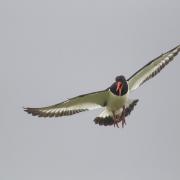Paul Hobson explores the strange and fascinating woodland world of fungi

During any particular year, as a wildlife photographer I try to set myself targets. These are usually very seasonal and as autumn approaches I turn my attention to trees, colours and, of course, fungi. Some years are better than others, 2013 was a superb year and I found some fantastic fungi in many locations across Derbyshire. The best autumns seem to come after wet summers. Dry summers are often poor for fungi as well as other autumn fruits.
I tend to head for mature woodland and, if I can check on the age of the wood, the older it is the better. We often loosely use the term ‘ancient woodlands’, but this is actually a very specific definition. It means woods that we are sure have existed continuously since 1600. These are often the very best woods for fungi, especially if they are managed well and old dead and dying trees are left to rot back down and produce good quality soil.
I love the woods at this time of year. Often the weak sun shines through the increasingly bare branches and creates delightful streaks of pale lemon across the rich browns, yellows and golds of the forest floor. The variety of woodland mushrooms is also often high and as I search and my eye refocuses to become a good mushroom detector again, I am usually certain to find a good range of photographic subjects. Other habitats that can be fruitful are ancient meadows and grasslands. Many old parks like Chatsworth, Kedleston and Calke Abbey have some superb old grasslands, that have never been ploughed or fertilised with chemicals. These are often productive to the mushroom hunter, though photographically they never quite offer the variety of opportunities that our woods seem to have.
I have never hunted fungi for the pot. When I was younger I liked the idea of living off the land, living in caves in woods and finding/hunting for all my food. I’ve since decided to file this in the drawer of idyllic childhood dreams. It does not take too long as an adult to see the sheer folly of the idea. Wet, cold, miserable and hungry! However, it seems, possibly due to the huge popularity of Ray Mears and Bear Grylls, that an increasing number of folk now want to venture out and snack from our countryside. This is a bit of a seasonal thing and is almost entirely restricted to fungi and fruits. Fungi forays are a great way to get out and learn more about the natural world that we live in but I am becoming increasingly concerned by the collecting of fungi for food. In the last couple of years I have left some lovely fungi for a few days with the aim of returning to photograph them when they have ripened or the light is better, only to find when I returned that they had been neatly cut out and taken. The delight and beauty that they could have offered has been denied to everyone bar the stomach of the picker!

The other major consideration is that many of our fungi are poisonous, some kill and many would make you very ill. The fairly recent story of Nicholas Evans, the author of The Horse Whisperer, and his family who were poisoned by webcap mushrooms should be a salutary reminder of the danger of picking for the pot. Nicholas eventually had to have a kidney transplant from his daughter.
I have spent some time recently researching the importance of fungi to both humans and the natural world. In Britain over 1,000 invertebrates depend on fungi for food. Many larger animals such as wood mice and badgers eat them. Most of the decay of wood and vegetation is carried out by fungi, many of which we never see. All trees live in complex relationships with fungi that help them to extract nutrients and water from the soil.
We have also come to rely on fungi in many ways. We use them to produce alcohol, antibiotics, vitamins, bread and, of course, we eat thousands of tons per year of commercially grown mushrooms. If all the fungi in the world disappeared overnight, our world and the natural one would quickly grind to a halt.
As I read more I discovered some remarkable and fascinating historical anecdotes. In ancient Egypt mushrooms could only be eaten by the Pharaoh. They believed that mushrooms were the ‘son of god’ and delivered to earth by lightning bolts. The preceding clap of thunder was to alert them to the mushrooms appearance. Roman writers and philosophers Pliny and Cicero loved them and considered them great delicacies. We all know how witches added them to their brews of frogs and bat’s wings and our history is rife with delightful references to mushrooms, including their psychedelic properties.

Today we see these organisms far more realistically but still marvel at their shapes, colours and mystery. They erupt as if by magic from the damp soil or woody trunks of trees. So, as the fungi season arrives, try to get out on a fungi ramble and learn about the strange and fascinating world of mushrooms in Derbyshire. I would plead with you though not to pick them but to leave them for others to see and marvel at, and for the natural world to exploit in its own way.
Related links:
All you need to know about mushrooms




























